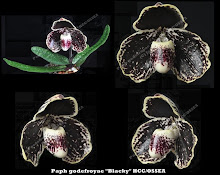Folks,
Some flowers to share.
 Paph godefroyae fma leucochilum 157-3
Paph godefroyae fma leucochilum 157-3:
This is the third bloom. Dark burgundy tessellation/markings over light cream base, clear spotless pouch and well balance between the dorsal and petals. The NS and DS measure 78 and 55 mm respectively.
 Paph godefroyae 3620-11
Paph godefroyae 3620-11 :
This is the #11 plant from flask . Very dark burgundy marking covering almost 80% of the flower with well marked pouch. It is almost similar to one of the siblings "Blacky". All the previous siblings are between 60 to 70 mm across the NS.
 Paph godefroyae 5120-4:
Paph godefroyae 5120-4:
This is the fourth bloom from this flask which took less than 2 years to bloom. Dark burgundy streaking markings yellow base.
 Paph godefroyae fma leucochilum 371-2.
Paph godefroyae fma leucochilum 371-2.
A fairly large flower with dark burgundy streaking markings over yellow base. A good balance between the petals and sepal. The NS and DS measure 77 and 50 mm respectively.
 Paph liemianum x concolor:
Paph liemianum x concolor:The features of this clone take more of the concolor parent. Magenta spots over the light yellow base. An easy to grow hybrid which is grown in SH (semi-hydro). About 1cm of the pot is submerged in water. This hybrid clusters very well. The above has about 10 shoots in it. The flowers come from two different shoot.


 Paph godefroyae fma leucochilum 157-3:
Paph godefroyae fma leucochilum 157-3:








